First Drive: BMW’s New 5 Series Lets You Actually Steer With Your Eyeballs, and We Road-Tested It
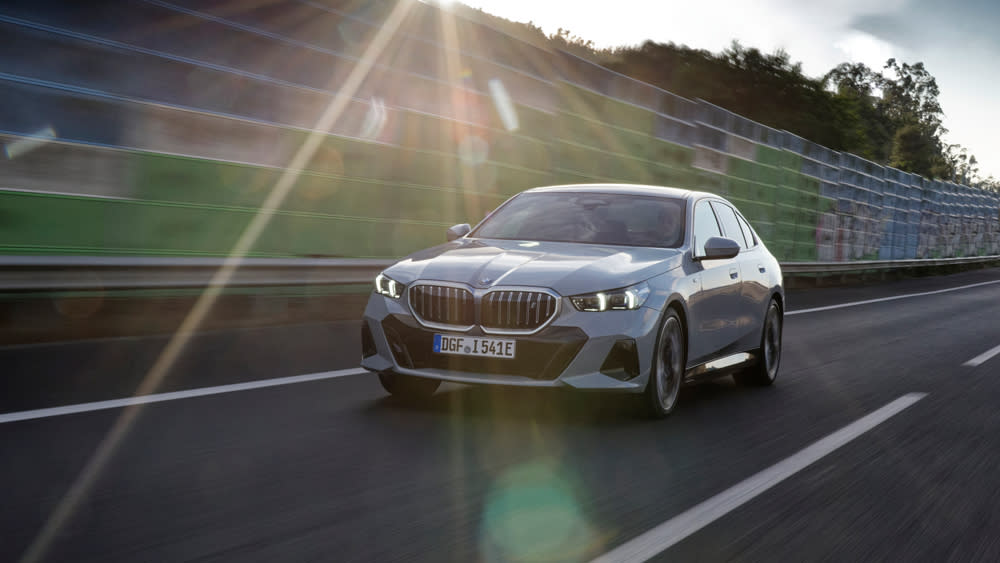
As a sign of the times, for the first media test-drives of its eighth-generation 5 Series sedan, BMW presented just two models, both electric-powered vehicles. That doesn’t mean the new model line is EV only—when the car goes on sale in the U.S., the lineup will also include variants powered by mild-hybrid internal-combustion engines. And enthusiasts need not panic: A muscular M5 is also coming.
The new 5 Series also takes BMW’s “ultimate driving machine” schtick in a startling new direction. An available adaptive cruise-control system allows you to steer the car from lane to lane on the freeway using only your eyeballs. Yes, you read that right: The 5 Series can be ordered with steer-by-eyeball technology. We’ll explain in a moment.
More from Robb Report
Ferrari Sold More Hybrids Than Conventional Gas-Powered Cars for the First Time Last Quarter
Toyota Unveils an All-Electric Sports Car Concept That Could Rival the Porsche Cayman
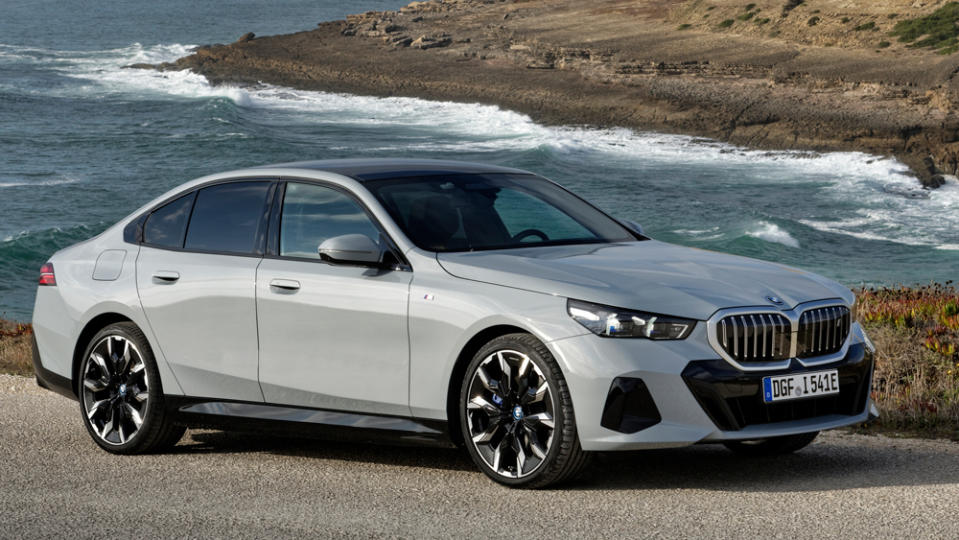
But first, the focus on electric power as the headline technology of the new 5 Series shows how serious BMW is taking the transition to EVs. Not that you’d immediately think so, as the i5 eDrive40 and the i5 M60 look just like contemporary internal-combustion-engined BMWs: Chiselled, athletic four-doors with big wheels and tires, a greenhouse with a Hofmeister-kinked C-pillar, and a grimacing kidney grille that looks ready to chomp slow-moving Toyotas. No aero-blob sheet metal here.
That’s because the new 5 Series has been designed from the ground up to accommodate mild-hybrid internal-combustion-engine power trains as well as plug-in-hybrid configurations. This, of course, is all in addition to full battery-electric versions. Such an approach allows BMW to build all three variants on the same production line, and to adjust the mix between power-train production to suit market demand.
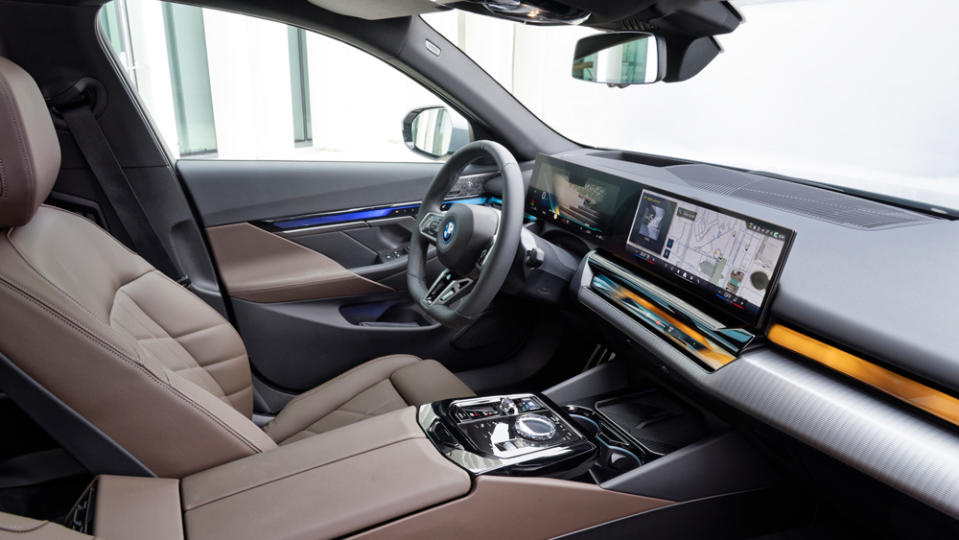
Usually, the risk of this convergence-platform strategy is that the inevitable engineering compromises involved result in a car that is competent at everything, but outstanding at nothing. However, the i5 eDrive40 and i5 M60 prove that if your engineers are good enough, it’s a risk worth taking. They might look like regular BMWs, but they are also impressive EVs.
The new 5 Series is slightly larger all round than its predecessor. Overall length has increased by 3.4 inches to 199.2 inches, width by 1.3 inches to 74.8 inches, and height by 1.4 inches to 59.6 inches. And the wheelbase has been stretched by 0.8 inches to 117.9 inches. Inside is an all-new interior that features a curved display screen which incorporates a 12.3-inch digital instrument panel behind the steering wheel, and a 14.9-inch touchscreen above the center console.
The screens are powered by the new BMW Operating System 8.5, which not only improves operational speed and graphics quality, but also allows functions such as video streaming and gaming courtesy of an app from gaming platform AirConsole that allows occupants to use their smartphones as controllers and can host multiple players.
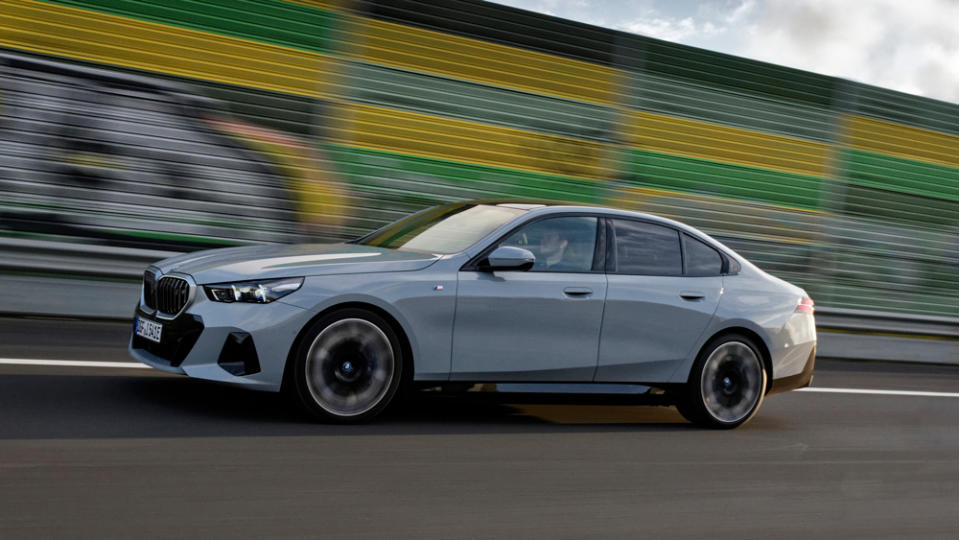
Both the i5 eDrive40, the entry-level EV model, and the sport-oriented i5 M60 have a battery with a total useable capacity of 81.2 kWh. Unlike the wide and flat battery packs that sit under the floor of so-called skateboard-platform EVs, the BMW battery fills some of the space in the transmission tunnel and the void ahead of the rear wheels left by the absent gas tank. This all gives the car a much thinner under-floor section. That translates to giving the i5 a lower seating position than most skateboard-platform EVs.
The i5 eDrive40 has a single e-motor mounted at the rear axle, driving the rear wheels. It produces 335 hp and 295 ft lbs of torque, though a paddle on the left-hand side of the steering wheel bumps that to 317 ft lbs by activating the Sport Boost or Launch Control functions. BMW claims the i5 eDrive40 will accelerate from zero to 60 mph in 5.7 seconds and has an electronically limited top speed of 120mph.
The i5 M60 adds an e-motor to the front axle to create an all-wheel-drive power train with a punch comprising 593 hp and 586 ft lbs of torque, or 605 ft lbs with Sport Boost or Launch Control activated. That’s enough to hurl this 5,247-pound sedan from zero to 60 mph in just 3.7 seconds, and to an electronically limited top speed of 143 mph on summer tires, or 130 mph on all-season rubber. The M60 also comes with the BMW M Sport Package, which includes M Sport brakes with red or blue painted calipers, plus Adaptive M Suspension Pro, which includes rear-wheel steering, along with standard heated front seats and a Bowers & Wilkins sound system.
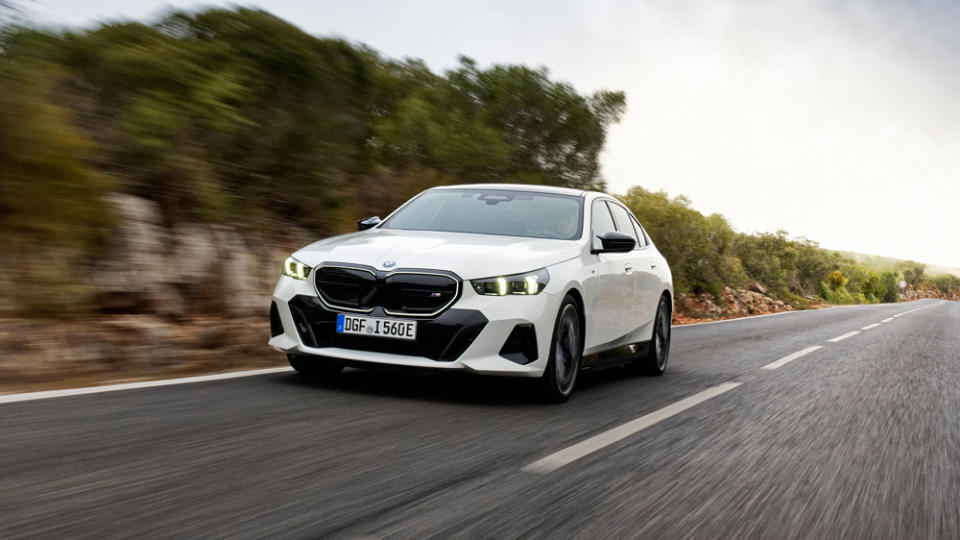
Both versions of the i5 are as smooth to drive as you’d expect of an EV, surging away from a standstill the moment you squeeze the accelerator pedal. But what impresses most is how remarkably well-suppressed the noise is, especially from the suspension and tires, and how well both cars ride, even in Sport mode. What makes the overall refinement of the i5 even more noteworthy is that our testers were fitted with the optional, top spec 21-inch wheels and low-profile Continental Eco Contact 6Q tires. The lower seating position also means the i5 feels more agile through the turns than its skateboard-platformed rival, the Mercedes-Benz EQE.
Of the two, the M60 is obviously the quickest on a fun road, darting out of corners as the dual-motor power train modulates the front-to-rear torque split for maximum traction. And though it has rear-wheel steering, you’re never aware of it snapping the tail around on slower turns as in some other cars with rear-steer; all you sense is great turn-in response with terrific front-end grip.
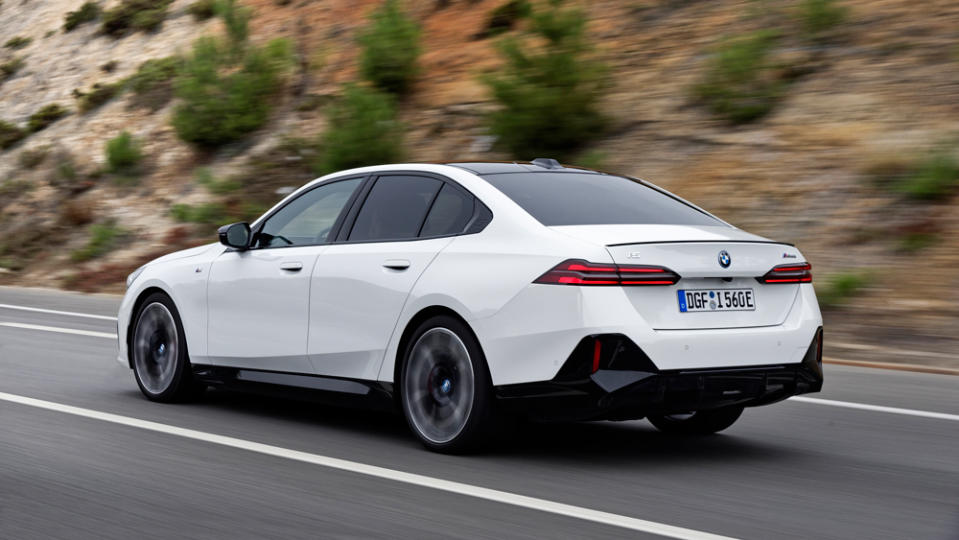
Priced from $67,795, the eDrive40 costs $18,300 less than the M60. But it feels every bit as smooth and refined on the road, courtesy of the standard air suspension at the rear, and shocks that automatically adapt their damping rates in direct relation to spring travel. And without power going through the front wheels, it also has slightly cleaner, more communicative steering than the M60.
The eDrive40 flows beautifully down a winding road and is almost as quiet on the highway as the ultra-luxe i7 electric limo. And with the same size battery as in the M60, powering just one e-motor in a car that’s 331 pounds lighter, the eDrive40 is claimed to travel 15 percent further on a single charge.
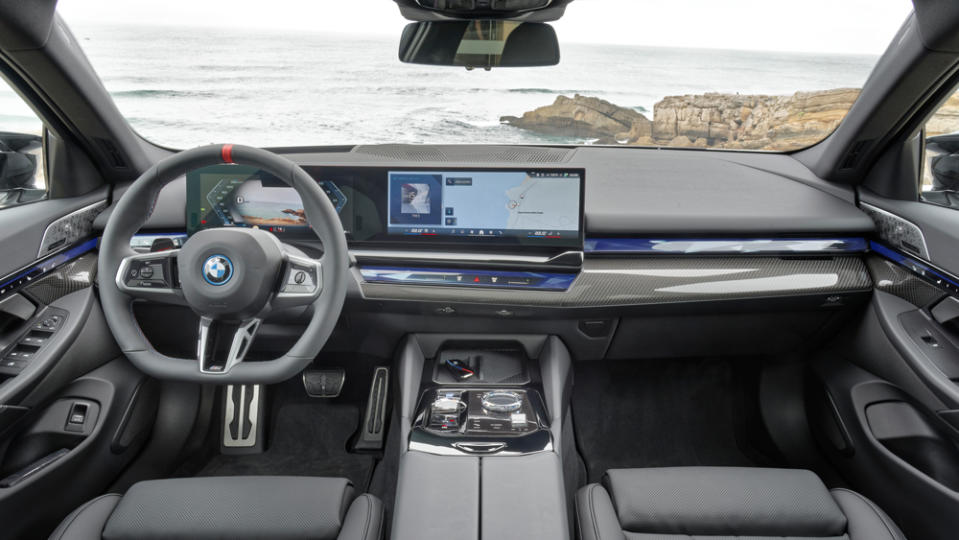
Speaking of which, the peak charging rate of 205 kW means the i5’s battery can be boosted from 10 percent to 80 percent in just 30 minutes when the car is hooked up to a fast charger. And first-time owners will receive two years of complimentary 30-minute charging sessions at Electrify America DC fast-charging locations.
One gripe: Unlike many other EVs, the i5 does not allow easy manual adjustment of lift-off regenerative-braking levels; you must go into a menu on the touch screen to choose between high, medium, or low recuperation levels. The car’s default setting is an adaptive recuperation mode that can use navigation data and information from sensors of the driver-assistance systems to adjust how much power is recuperated at any given time.
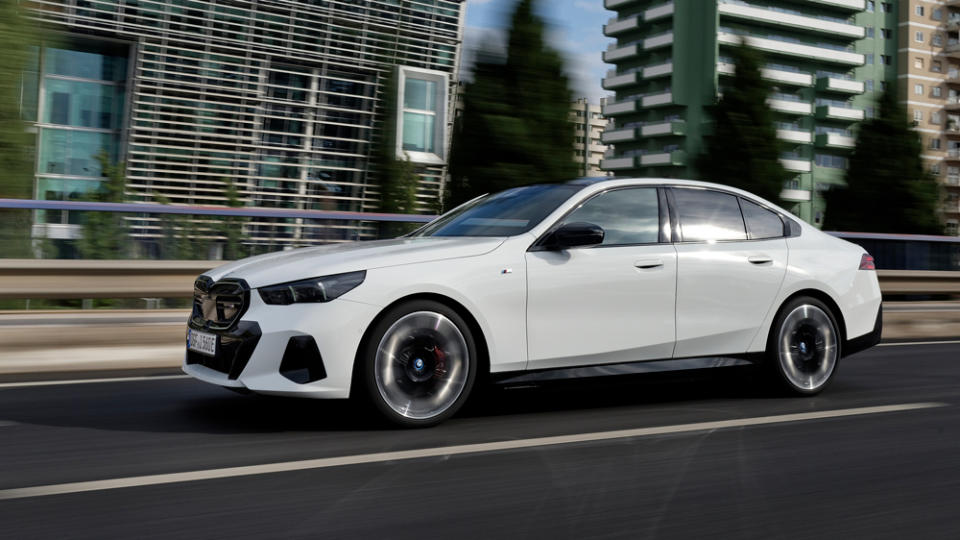
Steer-by-eyeball? Yes, it’s real, and a genuinely clever piece of lateral thinking. Part of the Driving Assistance Professional package—that’s available as an option across the new 5 Series range, and called Highway Assistant—the system uses cameras to ensure your eyes are looking ahead at the road when the adaptive cruise-control system is engaged. The logic here is simple: If it knows you’re looking at the road ahead, there’s no need for your hands to be on the steering wheel for the BMW to know you’re paying attention when its Level 2+ autonomous-driving systems are active.
Take your eyes off the road to, say, stare at your cell phone or scroll through menus on the central touchscreen, or turn your face away to look out the side window or at another passenger, and you’ll get a series of warnings before the system deactivates and forces you to take over the driving chores. Keep looking ahead and you can drive hands-free on a freeway at speeds up to 85 mph for as long as you want, the car turning, braking, and accelerating automatically in the traffic in response to data streaming through its suite of high-precision long-range radar sensors and eight-megapixel cameras.
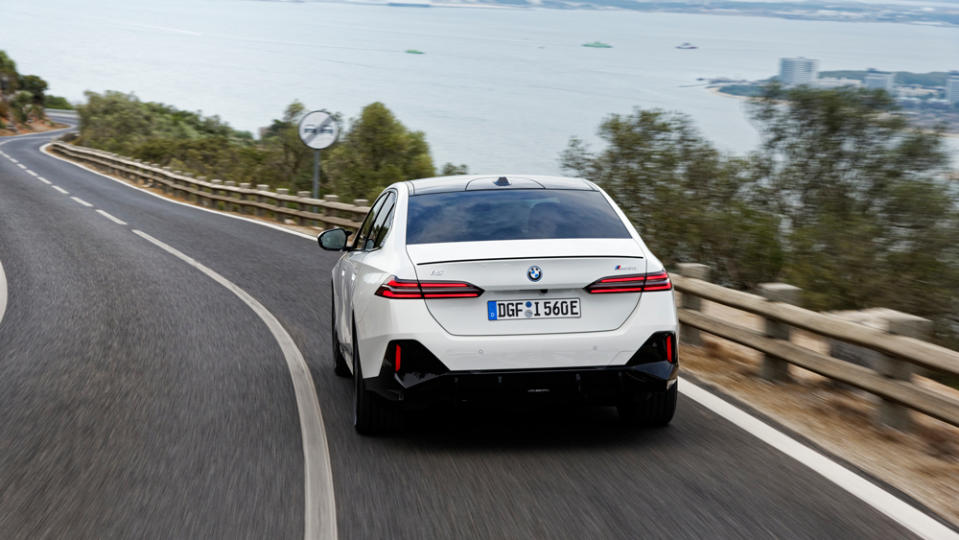
Now, here’s the clever bit. As in other cars with advanced Level 2+ autonomous drive systems, the BMW 5 Series can figure out whether it’s safe to change lanes to the left or to the right and will let you know when the maneuver can be made. Unlike other cars, though, you don’t have to touch the steering wheel or tap the turn-signal stalk to make it happen. Instead, you just look to the left or right at the exterior rearview mirror you would normally check before making a lane change, and the BMW will activate the correct turn-signal move all by itself. It sounds disconcerting. But after only a couple of minutes it becomes as natural as breathing. Relaxing and easy to use, Highway Assistant is a game changer.
The electric-powered i5 models will be joined by the mild-hybrid, internal-combustion-powered 530i and 530i xDrive variants, priced at $58,895 and $61,195, respectively. These models are powered by BMW’s 2.0-liter TwinPower turbocharged four-cylinder engine that produces 255 hp and 295 ft lbs of torque. The rear-drive 530i will accelerate from zero to 60 mph in 5.9 seconds, while the xDrive’s all-wheel-drive traction gets it to 60 mph from standstill in 5.8 seconds.
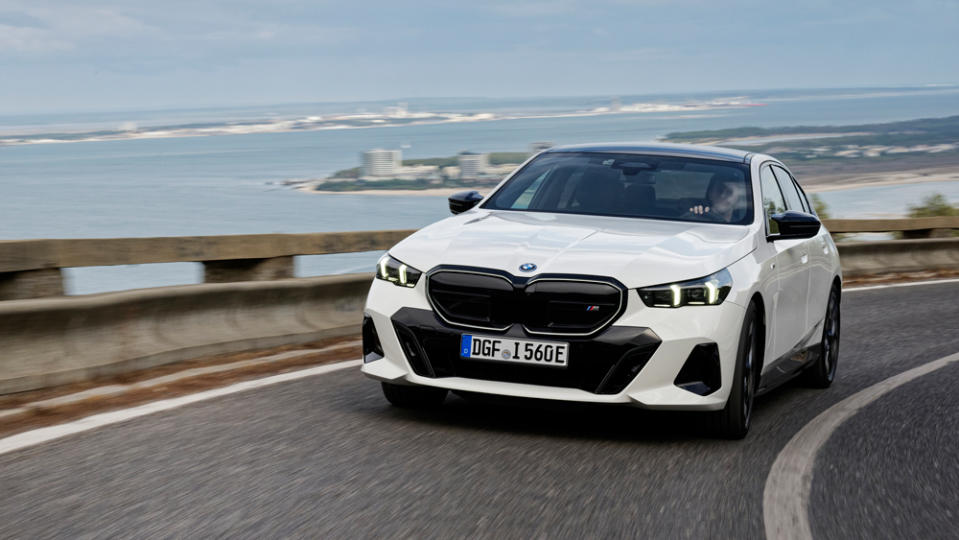
The 5 Series lineup will be later expanded to include the $65,985 540i xDrive, which goes into production this month and features a more powerful iteration of BMW’s 3.0-liter, turbocharged inline-six engine under the hood and an e-motor mounted between the engine and the eight-speed transmission. Total system output is 381 hp and 398 ft lbs of torque, which will enable the 540i xDrive to hit 60 mph in 4.7 seconds.
BMW execs won’t reveal any details on the forthcoming M5, other than to hint that it will be a plug-in hybrid like its arch-rival, the Mercedes-AMG E63. That suggests it will have the 3.0-liter six under the hood supported by powerful e-motors that will deliver a total system output of about 700 hp. Oh, and European customers will be able to buy a wagon version.
Best of Robb Report
Sign up for Robb Report's Newsletter. For the latest news, follow us on Facebook, Twitter, and Instagram.

